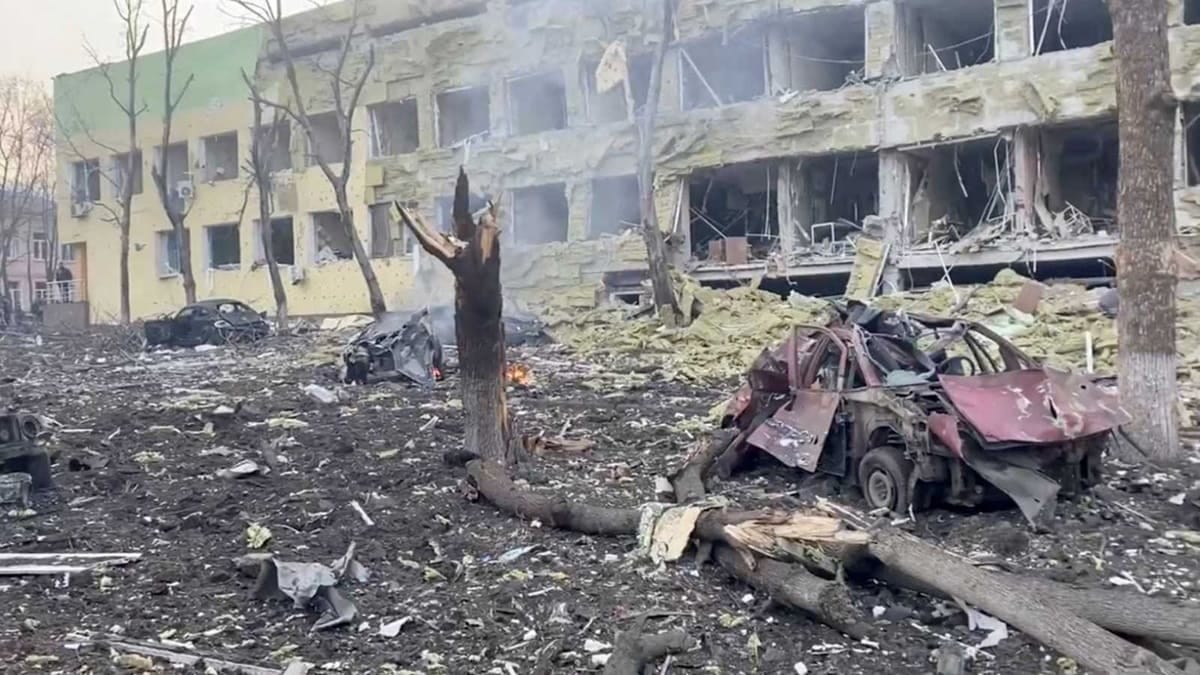The Pregnant Beauty Blogger and the Kremlin Propagandists
Sorting through the lies.

For the Kremlin propaganda machine to hit a new low is quite a challenge. But it has managed to do that again and again during the war in Ukraine—and there is probably no better (or worse) example than the story of the pregnant Instagram blogger from Mariupol who was caught in the bombing of a maternity hospital. In the end, the Kremlin’s spin didn’t work, but not for lack of trying (with help from a few useful idiots in the West). On March 9, a week after Russian forces encircled the southeastern city of Mariupol, a Russian airstrike hit the city’s Hospital No. 3, a complex that housed a children’s wing and a maternity wing. The images were devastating: a heavily pregnant, bleeding woman, obviously in shock, being carried on a stretcher across the rubble-strewn hospital yard; another pregnant woman being helped down the stairs and then standing in the yard wrapped in a blanket, with visible cuts on her face.
The spin began almost immediately. On March 10, Russian Foreign Minister Sergei Lavrov claimed that the hospital was “occupied by militants of the Azov Battalion along with other radicals, who set up a base there”—though, somewhat confusingly, he simultaneously claimed that the “radicals” were “turning people into human shields” and that “there [had] been no women, children, or staff in this maternity hospital for a long time.” The Russian embassy in the United Kingdom promptly tweeted out Lavrov’s statement, along with a photo of the bombing aftermath with “FAKE” stamped over it in large red letters, and then followed with another tweet claiming that “beauty blogger Marianna Podgurskaya . . . actually played roles of both pregnant women on [sic] the photos.” One of the two women—the one who came down the stairs on her own—was indeed Podgurskaya; but she really was pregnant, a fact that could be easily ascertained by looking at her earlier Instagram photos. The embassy acknowledged this, but only to insist that she was using “very realistic makeup” to fake her injuries and that in any case she could not have been at the hospital at the time of the strike, since “it has long been taken by the neo-Nazi Azov Battalion who told all the staff to clear the place.” (The tweets were later removed by Twitter.) The Russian ambassador to the Netherlands, Alexander Shulgin, repeated the lie in a TV interview, claiming with a straight face that Podgurskaya had “changed clothes” to play the second woman on the stretcher. Meanwhile, on this side of the Atlantic, former Trump staffer A.J. Delgado chimed in: https://twitter.com/SykesCharlie/status/1501648019766325254 In early April, after the claim that Podgurskaya was the pregnant woman in both photos had been easily debunked—and after reports that the woman on the stretcher, whose pelvis had been crushed in the bombing, had died after her stillborn baby was delivered by Caesarian section—the story took a new turn. A video interview with Podgurskaya (using her married name, Vyshemirskaya), who had delivered a baby girl two days after the bombing, showed up on the YouTube channel of Denis Seleznyov, a blogger from the self-proclaimed Donetsk People's Republic. Pro-Kremlin accounts quickly spun it as evidence that the hospital strike was indeed a false flag.
There was no air raid, none of those present heard the noise of the planes, there was a projectile. She confirmed that the Ukrainian army used the maternity hospital for their own purposes and also took food away from women in labor. — Jose Dominguez (@JoseDom74253154) April 7, 2022
https://twitter.com/BiteYrAnkles/status/1513036302324797440 Delgado rushed back into the fray with an “I told you so.”

Once again, as in Lavrov’s early statement on the bombing, the spin featured two mutually contradictory theories: one, the hospital bombing was probably a Ukrainian false flag operation using a Ukrainian missile; two, the Russians did bomb the hospital, but they considered it a legitimate target because the Ukrainian military was using it as a base to fire on Russian troops. Some spinmeisters also seized on Vyshemirskaya’s claim that Associated Press photographers showed up almost immediately on the bombing site to insinuate that the attack was probably staged. (In fact, the photographers arrived about 25 minutes after the explosion and filmed the plumes of smoke it caused from a nearby building.) But what did Vyshemirskaya actually say? Did she expose the hospital attack story as a fake? Did she, as some suggested, speak under duress, since she was clearly in Russian-controlled territory? There is, in fact, absolutely nothing in the interview on YouTube to suggest that the attack was staged. Yes, Vyshemirskaya (who had lived in the village of Makiyivka on the territory of the “Donetsk Republic” until she married a man from Mariupol in 2020) did claim that her story had been misrepresented by the press. But the only significant discrepancy she identified was that both Ukrainian government officials and most of the media reported the attack as an airstrike, while Vyshemirskaya claimed that “no one” had heard an airplane overhead before the building was hit and that afterward, when the women had gone down to the basement for shelter, hospital staffers told them it was not an aerial strike. But, first of all, the alternative—rocket shelling—does not seem much better, unless the implication is that the rocket came from the Ukrainian side. And second, as the Washington Post reports, both eyewitness accounts and video from Associated Press journalists strongly suggest an airstrike, as does the physical evidence of “a crater outside the hospital that went at least two stories deep.” This does not mean that Vyshemirskaya is lying: a thorough analysis by the Latvia-based Russian- and English-language website Meduza quotes military experts who say it is entirely possible not to hear the sound of an airplane before a bombing, since that sound may only be audible seconds before the blast. Moreover, some of Vyshemirskaya’s statements in the YouTube interview with Seleznyov are clearly false. For instance, she asserts that the AP crew filmed her in the hospital yard against her stated wishes (even though raw footage posted on the AP website shows that she did not object to being filmed) and that, in an interview two days later, she told the AP there was no airstrike. What she actually said was this: “I didn’t see with my own eyes from whom it flew in, from where, what and which direction. We don’t know. There are many rumors, but in fact we can’t say anything.” Whether Vyshemirskaya is misremembering, which would be entirely understandable under the circumstances, or trying to please the authorities in the “Donetsk Republic” to which she was evidently evacuated (willingly or not), is hard to say. However, it is worth noting that at some points during the interview, she deflects the interviewer’s attempts to make the Ukrainian forces look like the bad guys. Thus, when she says that many civilians trying to use evacuation corridors from Mariupol were turned back, the interviewer chimes in to clarify that Ukrainian soldiers were the ones preventing them from leaving; but Vyshemirskaya’s reply makes it fairly clear that they couldn’t leave because it was unsafe.
As for the maternity hospital being allegedly taken over by soldiers, this is where the spin on Vyshemirskaya’s actual words crosses over into outright falsification. What Vyshemirskaya does say, in the process of explaining how she ended up at that particular maternity ward, is that a different maternity hospital in the city—Hospital No. 1, which had the best equipment—was unavailable because soldiers had set up base there and the patients were transferred to Hospital No. 3. The reason Ukrainian soldiers had taken over Hospital No. 1, she says, is that it had solar panels, ensuring a continuous power supply. (The interviewer makes a caustic comment about soldiers being given priority over pregnant women; but such decisions in a city under intense attack are not necessarily wrong.) Later, Vyshemirskaya does say that on one occasion soldiers came over to Hospital No. 3 and asked for food, saying that they hadn’t eaten in several days. This is the narrative that the “Donbas Devushka” account retweeted by Delgado conflated into “Ukrainian soldiers kicked the mothers out and stole their food.” (That account was later permanently suspended by Twitter.) Indeed, after the interview was released, Vyshemirskaya clarified in a Telegram post that the maternity hospital where the soldiers set up their base was not the hospital that was bombed:
Don’t confuse it with Maternity Hospital No. 1, which is a perinatal center and is located on the outskirts of Mariupol—that building was taken over by the military in late February. They asked all maternity patients to go home, and they sent the rest to Hospital No. 3, where I was from March 6 to March 9. So it was functioning—there were workers, pregnant women, and new mothers there.
All in all, it’s not clear that Vyshemirskaya’s interview helps the Russian side all that much. Even if her account casts doubt on whether the attack on the maternity hospital was an airstrike, it was still an attack on a maternity hospital which had most certainly not been cleared of patients and staff. Then again, the strategy of the Kremlin propaganda machine is not to create a convincing alternative narrative but to sow confusion and doubt. Who cares if it’s a real-life reenactment of the old fable in which a man who borrows his neighbor’s kettle and returns it broken claims that he never borrowed it, that it was already broken when he borrowed it, and that he returned it intact? Pro-Kremlin accounts are still using Vyshemirskaya’s interview to suggest that the Western media had concealed the truth about the hospital bombing. Luckily, by now, only the useful idiots are still listening.


